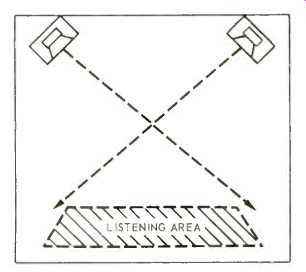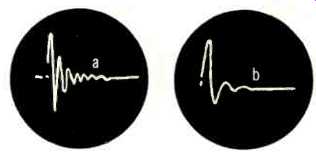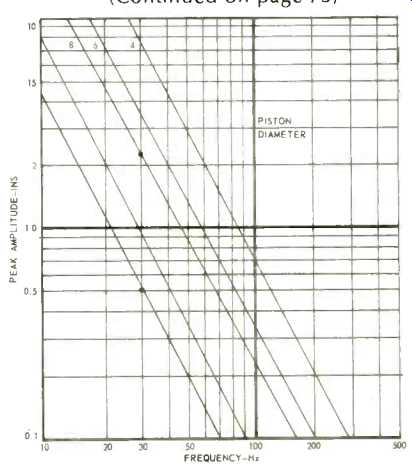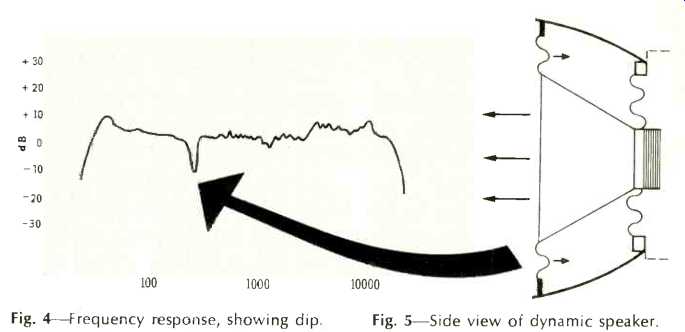Selected for general interest from enquiries received recently.
Q. What is meant by the efficiency of a loudspeaker system? A. The efficiency of a loudspeaker system is the ratio of acoustic power to the electrical input. It is expressed as a percentage and it ranges from around 25% for large corner horns right down to 4% or even less for small bookshelf systems.
(Not that bad when you consider that the efficiency of the human voice is only about 2%) Loudspeaker efficiency is directly related to amplifier power and in a room of average size you would need a minimum of 20 watts per channel for a low efficiency system but only 10 watts per channel for a speaker of 8 to 10% efficiency.
Q. I have a pair of speakers that are too directional and I find I only get good stereo from one position in the room. Is there anything I can do to improve matters?
A. That stereo seat was all too common in the early days of stereo ( Just listen to this record, no not in that chair-sit over here!) before the dispersion requirements were fully appreciated. If your speakers are fairly old, the best advice is to buy new ones. You could replace the treble units but many systems are difficult to disembowel without causing damage and then again-who knows what the frequency response will he like when you have finished? Much easier to add an external speaker, but before you try that why not angle the systems inward as shown in Fig. 1. This is called the "Hugh Brittain" arrangement and it works like this: a listener in the center of the shaded area will get good stereo as might be expected, but as he moves towards the left speaker he will also move into the axis of the right speaker. Thus the tendency of the nearer left speaker to sound louder will be offset by the increased intensity of the right speaker-and vice versa. So, according to the theory, the stereo image will be central over a wide area. I have found that this arrangement can work very well indeed, especially with some of the more directional horn systems. Incidentally, Hugh Brittain was the designer of the first successful loudspeaker to use a metal cone-the British GEC model 1851.

Fig. 1--The "Hugh Brittain" arrangement.
Q. I have often read that the transient response of a small bass speaker system is superior to that of a large one. How much truth is there in this?
A. First let us define the question and see what is involved. A loudspeaker in a closed box will have a natural resonant frequency, that is the frequency at which it will tend to vibrate if excited by an electrical signal or mechanical impulse. If the box is vented, then there probably will be two such resonances, the upper one ( usually in the 80to 150-Hz range) being the most prominent. If these resonances are not damped sufficiently the result would be that "one-note-bass effect" or a kind of hangover. [Also referred to as "overhang"--probably by writers more familiar with another context for "hangover."] Damping is applied acoustically by the stiffness of the enclosed air in the box and electrically by the loudspeaker's magnetic system and to a lesser extent by the low output resistance of the amplifier acting as a "brake." One way of testing the transient response is to apply a sharp electrical pulse to the loudspeaker and monitor the output with a microphone connected to a oscilloscope which gives a visual indication. Figure 2a shows what happens when a pulse is applied to a loudspeaker with hangover and it can be seen that the cone still keeps moving after the pulse has been switched off. Contrast this with Fig. 2b which shows the response from a well-damped system; as soon as the pulse is switched off, the cone comes to rest.

Fig. 2--Pulse waveforms.

Fig. 3--Peak cone excursions vs. frequency (for 1 acoustic watt).
Now we will consider two bass systems, one with a big 15-inch woofer and the other using an 8-inch unit. A glance at the chart ( Fig. 3) will show that the 8 inch speaker cone has to travel nearly 5 times the distance of the larger one to produce the same amount of sound (or move the same amount of air) at 30 Hz.
This means that the magnetic field has to be much longer to accommodate the long excursions of the voice coil, However, providing this is done and the acoustic damping requirements are met then there should be no significant difference between the two systems as far as low frequency transient performance is concerned. The small system will of course need more power to drive it and the long voice-coil traverse brings other problems. For instance, both the centering spider and cone surround have to allow for large movements without distortion. Linearity is not too easy to achieve with the spider and the wide, flexible surround causes more headaches for the designer. Figure 5 is a side view of a dynamic loudspeaker and it shows how the surround can move the opposite way to the cone at some frequencies. This uncooperative behavior causes a phase cancellation dip in the frequency response as shown in Fig. 4. Various methods are used to overcome or minimize this fault--usually treating the surround with resinous "gooey" materials or the adoption of special concertina configurations. The 15 inch job does not have these problems, instead the emphasis is on cone rigidity to prevent break-up, nodes, and so on--plus the complications of choosing the right strength-weight factor. In other words, it's all a question of proper design, both systems have their merits and their own particular problems.

Fig. 4--Frequency response, showing dip.
Fig. 5--Side view of dynamic speaker.
Q. What are the advantages of electrostatic speakers?
A. If you are referring to the push-pull models as opposed to the inexpensive single-element types, the advantages are as follows: low distortion (partly due to the push-pull cancellation ), good transient response, and low coloration. Full-range models have no enclosure resonances simply because they have no enclosure ( there's logic for you!). Disadvantages--to be fair we must mention those--are the necessity of providing an energizing voltage and the fact that full-range models are a little restricted in power output at the extreme bass. Increasing this would mean wider plate spacing with a higher polarizing voltage, a larger diaphragm, or both. Acoustically, electrostatic speakers are subject to the same laws as dynamic types, e.g. they still have diaphragm break-up and nodes to contend with. Because of the large size-to-mass ratio of the diaphragm they have a very low acoustical output impedance, consequently bass output is highest when they are placed in the center of a room-quite unlike dynamic speakers in that respect.
Commercial systems are designed to give a balanced output when placed one to three feet from a wall. The figure-8, or doublet radiation pattern may not always be desirable although in some rooms it does make for a more spacious sound.
Laboratory models with suppressed back radiation have been made ( and demonstrated) but so far none has reached the market.
(Audio magazine, Mar. 1970)
Also see:
Speaker Q's and A's Mainly for Beginners (Mar. 1972)
How to Choose a Loudspeaker (Mar. 1970)
What Price Loudspeaker Response Curves (Mar. 1972)
The Acoustic Feedback Loudspeaker System (Jan. 1972)
Speaker Tests: Room Test by Richard C. Heyser (Jan. 1975)
Speaker Tests--Phase Response (by Richard C. Heyser) (Dec. 1974)
= = = =